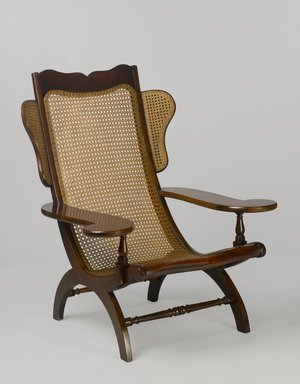Browse

| Accession # | 2011.58.1 |
|---|---|
| Maker | Unknown |
| Title | Easy Chair (Butaca) |
| Date | second quarter 19th century |
| Medium | Mahogany, cane |
| Dimensions | 43 x 35 3/4 x 35 3/8 in. (109.2 x 90.8 x 89.9 cm) |
| Marks | Unmarked |
| Credit Line | Gift of Mrs. J. Fuller Feder, by exchange and Brooklyn Museum Collection |
| Location | Visible Storage: Case 34, Shelf E (Spanish Colonial Art) |
| Description | Mahogany and cane easy chair (Butaca) with curved, inverted 'U' shaped legs. Tall mahogany easy chair with continuous curved back and seat, curved and notched top crest rail, on each side at front upper corner of crest a mahogany and cane long ear- shaped wing. Slight incline to back curving down to a wide, ample seat with scalloped seat rail. At midpoint of back stiles on either side, a thick, horizontal armrest attached to seat base with an upright, short, turned support, legs consist of a continuous inverted 'U' shape on either side with a turned stretcher at rear and front. Old cane on side wings, new cane on main body. |
Curatorial Remarks: Butacas, colonial low easy chairs derived from pre-Columbian seat forms (see illustration), were ideal for intimate domestic spaces. The elite eighteenth-century example here includes carved rocaille decoration—fanciful sinuous curves with origins in the irregular edges of shells and rock formations—and cabriole legs adorned with a dog’s head and a bird (possibly references to the owner’s pets or interest in animals). The later mahogany-and-cane Cuban butaca includes foreign elements such as wings and a top rail molding.
The butaca type spread throughout the Caribbean and key ports along the Gulf of Mexico, particularly after Charles III signed the 1778 decree of free trade, which allowed Spanish American ports to trade directly with one another and with most ports in Spain.
Las butacas, sillas coloniales bajas derivadas de los asientos precolombinos (ver ilustración), eran ideales para amoblar los espacios domésticos más íntimos. Este ejemplo de élite del siglo XVIII incluye una decoración tallada de rocallas—curvas caprichosas y sinuosas inspiradas en los bordes irregulares de las conchas y formaciones rocosas—y patas cabriolé adornadas, una con la cabeza de un perro y la otra con un pájaro (una posible referencia a los animales domésticos del propietario o a su interés en los mismos). La butaca cubana tardía de caoba y esterilla de mimbre incluye elementos ajenos al repertorio ornamental tradicional español, como las alas y la moldura superior.
Este tipo de butaca se extendió a todas partes del Caribe y a los principales puertos en el Golfo de México, en particular luego de que Carlos III firmara en 1778 el decreto de libre comercio, que permitió a puertos de Hispanoamérica comerciar directamente entre ellos y con la mayoría de los puertos de España.